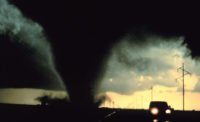How does extreme weather affect crane safety?

Source: Getty Images
Extreme weather conditions can be a big challenge when operating overhead cranes, which are key machines used in manufacturing and construction. As such, understanding the effects of severe weather and implementing best practices is a vital part of keeping both operators and equipment safe.
Below, we’ll briefly go over the risks posed by harsh weather conditions as well as a few essential guidelines for safely operating overhead cranes when the weather turns.
Wind
High winds can dramatically affect crane operations. Cranes, especially those that are high and have a significant surface area, can act like sails. Strong winds might make the crane's load swing around, which can create control problems or even cause the load to hit other objects. Wind can also make the crane structure itself unstable, increasing the risk of collapse under the worst conditions.
Extreme cold
Cranes can experience mechanical problems when the temperature drops significantly. Systems that use hydraulic fluid may slow down and metal parts of the crane can become brittle, both of which increase the risk of fractures or mechanical failure. In these conditions, operators must handle machinery more carefully as lubricants may thicken, reducing effectiveness and increasing wear on moving parts.
Rain
Heavy rain or consistent rainfall can significantly impair crane operation as well. It could impact how well operators can see and make the crane and its load slippery, which adds risk during lifting and moving. Plus, if water gets into the electrical systems or controls, it can potentially lead to malfunctions or failures.
Other weather events
Lightning and snow bring their own challenges. A lightning strike can damage the crane's electrical systems or even start a fire while snow can reduce visibility just like rain, and make surfaces slick, increasing the chance of accidents.
Best practices for safe crane operation
Special attention is required to reduce risks and make sure the crane operates within safe parameters during adverse weather conditions. Necessary steps in this approach include:
Understanding weather limits
Each crane model comes with manufacturer specifications that include weather limitations. Operators must be aware of these guidelines — such as the maximum wind speed and the temperature range — and respect them to avoid operating the machinery under potentially dangerous conditions.
Performing regular maintenance and inspection
Regular maintenance is crucial, especially in harsh weather conditions. This includes frequent checks of mechanical parts, lubrication systems and the integrity of the crane’s structure. Operators should perform a full check-up before using the crane to detect any irregularities that could be exacerbated by extreme weather.
Implementing safety technologies
Technology can play a pivotal role in enhancing crane safety. For instance, anemometers can measure wind speed and can be integrated into crane systems to provide real-time data to operators. There are also load moment indicators that assess if the crane and its load are stable, alerting the operator if something is off.
Enhancing operator training and preparedness
Operators must be thoroughly trained not only in crane operation but also in emergency response techniques specific to weather-related incidents. Training with simulations can be very helpful in preparing operators for the challenges they might face during severe weather conditions.
Taking special considerations for load testing
Crane load testing is an essential part of maintaining equipment safety, particularly when preparing for extreme weather operation. This test involves loading the crane to its full capacity under controlled conditions to confirm stability and operational reliability. Regular load testing can verify the machinery meets OSHA requirements and even help identify potential mechanical failures before they become critical.
Maintaining continuity and safety going forward
By understanding the specific dangers posed by different weather conditions, implementing rigorous maintenance routines and investing in proper training and technology, manufacturing and construction professionals can uphold the highest safety standards. The goal is not just to protect the equipment but, most importantly, to safeguard human lives.
After all, operating under harsh conditions demands respect for nature’s power and a commitment to safety that should never be compromised.
Looking for a reprint of this article?
From high-res PDFs to custom plaques, order your copy today!







.jpg?t=1721257160)